GDT > Features > Light Rail Safety > Light Rail Crisis

We try to avoid hyperbole at GDT, but it is now very clear that RTD is experiencing a crisis in terms of the state-of-good-repair of its Light Rail system. A wave of 10mph “slow zones”, imposed after a new track inspection methodology was implemented discovered multiple defects such as “rail burn”, coupled with the coping panels project and downtown light rail reconstruction project have made the published schedule unworkable leading to the E, H and R lines becoming virtually unusable for riders.
“Customers and the general public must be confident that the RTD transit system is a safe system. Recent events have shaken that confidence along the SE Corridor.”
Rebecca White, Colorado PUC Director, June 2024
What has caused the crisis?
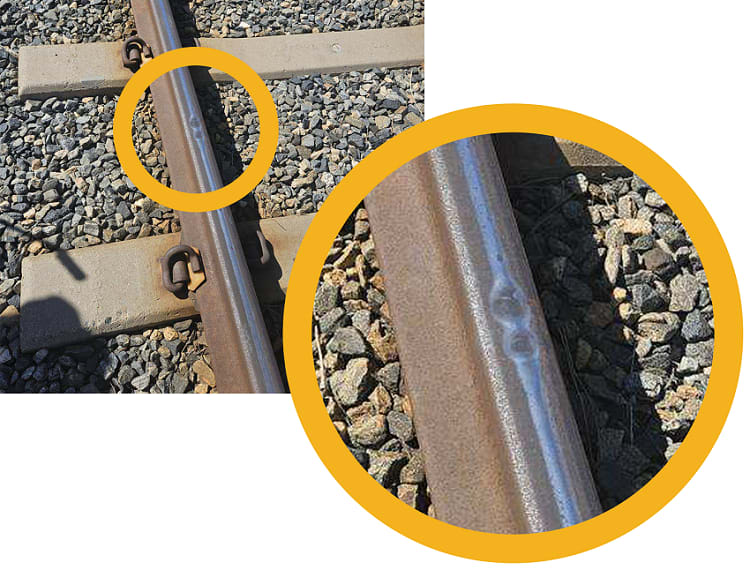
In May 2024, RTD’s Light Rail Maintenance-of-Way (MoW) Department implemented an “enhanced inspection methodology” for its light rail track inspections. This was as a result of an item in Corrective Action Plan CAP02 that was submitted to the Colorado Public Utilities Commission (PUC) as part of RTD’s response to the 19th and Stout Condemned Rail Incident.
The inspections found multiple instances of “rail burn” which we were told at the time lead to the imposition of multiple 10mph “slow zones” until they could be rectified.
“Rail burn” is caused by train wheels slipping as they accelerate. It is not an age related defect and can therefore be present on newly laid track as much as track that is 30 years old. If left untreated “rail burn”, acts like that chip in your car’s windshield – it will lead to cracks and eventually your windshield (rail) will shatter completely with potentially disastrous results.
For less serious instances, rail burn can be remedied with grinding, which is a process similar to sanding down the top of the rail. Larger and deeper instances cannot be remedied and the only course of action available is to replace the affected section of rail.
RTD Says They Are Now Using “APTA Standards”
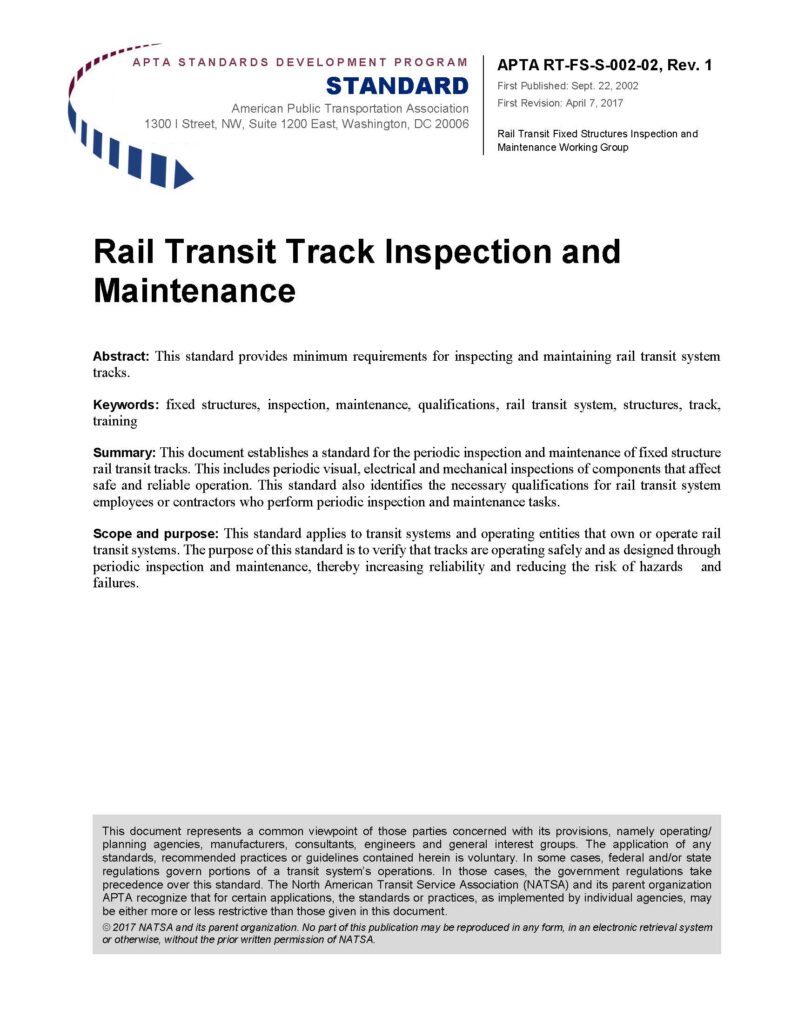
RTD initially explained that since May 2024, they had been using the American Public Transportation Association (APTA) standards for the track inspection and maintenance. Let’s take a closer look into what the APTA standards say…
Section 3.1a Track Inspection

Section 3.1a details the frequency and method of carrying out track inspections. The APTA standards say you can either inspect the track on foot or ride in a vehicle it at a speed that allows defects to be found.
Table 11c Rail Defect Remedial Action
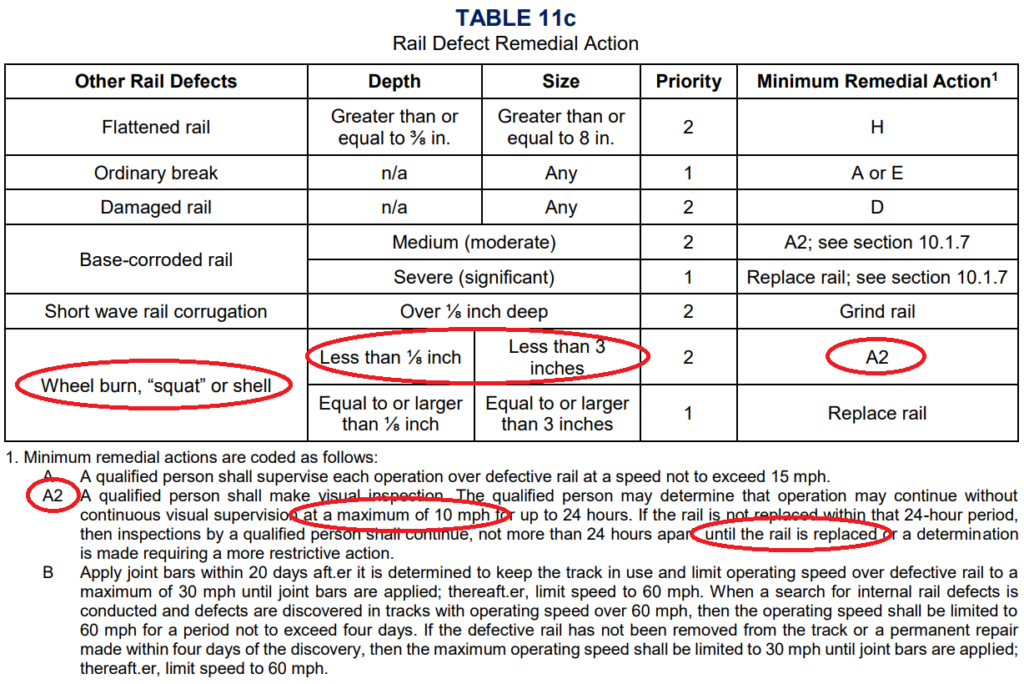
Table 11c details what to do when certain rail defects are found. For “rail burn” (also known as “wheel burn”) you can easily follow the minimum remedial action to imposing 10mph “slow zones”.
What standards were RTD using previously?
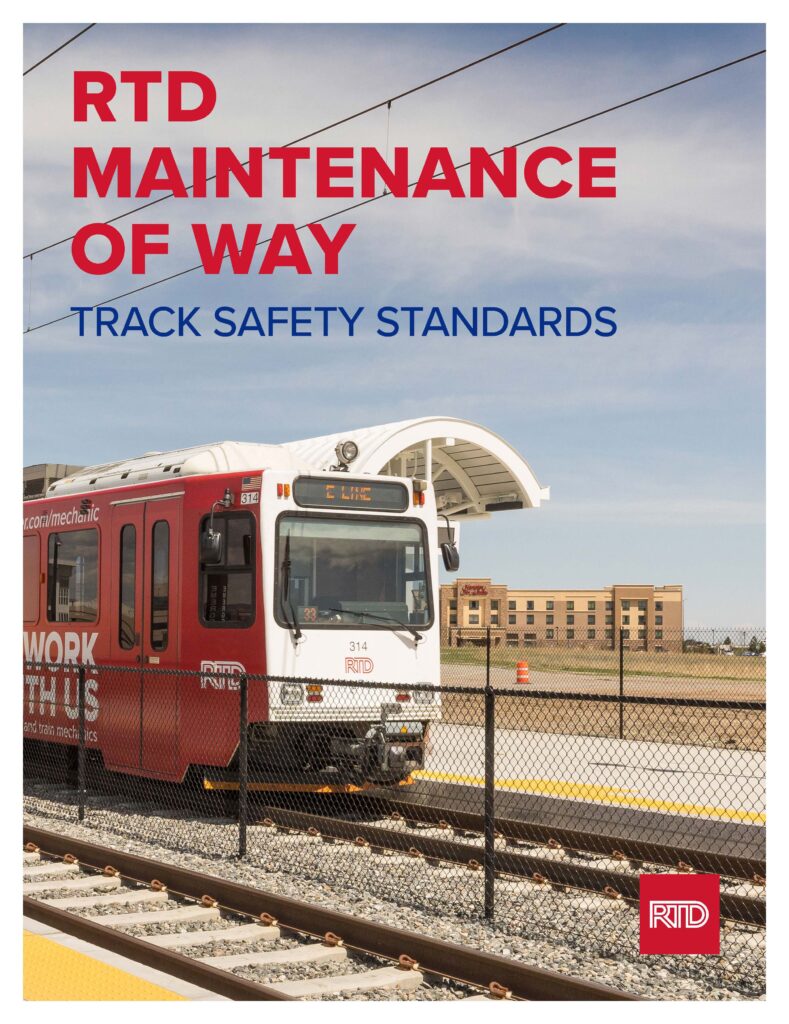
On May 10th, 2023 (note year), RTD told the Colorado PUC that “the current RTD MOW Track Safety Standards 2021 is a direct adaptation of the APTA-RT-FS-S-002-02 Rail Transit Track Inspection and Maintenance Standard, Revision 1, published in 2017”.
But… in an email to GDT on July 12, 2024, RTD stated “Following the development of standard operating procedures and training materials, and upon the completion of required employee training, the standard [2021 RTD Maintenance of Way Track Safety] was fully implemented May 1, 2024.”
So which standard exactly is / was RTD using, and when did the change happen?
Section 3.1a Track Inspection (RTD’s Version)
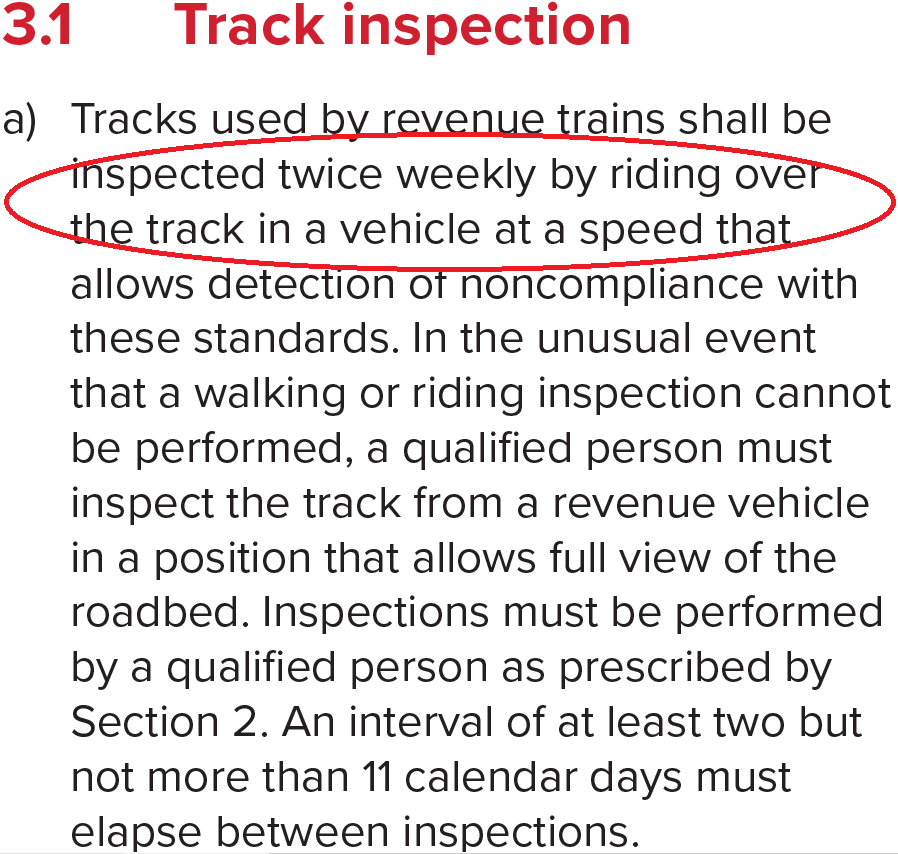
A comparison of Section 3.1a in both standards documents reveals RTD made some edits. The weekly track inspections on foot option was removed but the frequency of vehicle based inspections has been doubled to twice weekly. Note the second sentence clumsily refers to a “walking inspection” that now doesn’t exist!
Table 11c Rail Defect Remedial Action
This table is identical in both the 2021 RTD Maintenance of Way and the APTA standards. This means that RTD has known since 2021 that “rail burn” would possibly lead to 10mph slow zones being imposed.
So what’s actually changed?
“Staff walk the entire system every 90 days to take additional measurements and carefully document anomalies. The quarterly walking inspections allow the agency to take measurements, collect thousands of data points, identify recurring issues, and analyze patterns. The actual month of an inspection may be adjusted within a quarter.”
RTD Website, June 2024
Neither APTA standards nor the 2021 RTD MOW Track Safety Standards mention conducting track inspections at an interval of 90 days, however RTD has been attributing the imposition of 10mph “slow zones” as a result of when walking inspections are carried out on each individual line. Therefore it has to be concluded that it is these walking inspections are what has directly changed (being the “enhanced inspection methodology“) and have set off the crisis.
Could RTD staff have reasonably foreseen the sudden imposition of 10mph “slow zones”?
RTD has maintained throughout that staff could not have reasonably foreseen the sudden imposition of 10mph “slow zones”.
GDT now finds this extremely hard to believe given that a track inspection methodology which mandates the “slow zones” as a response to instances of rail burn has existed within the agency since at least 2021.
Crisis Timeline
Jun 3rd, 2024 – 10mph “Slow Zones” Suddenly Appear on the E, H & R Lines
RTD suddenly and without warning imposes two 10mph “slow zones” between Colorado and Yale stations on the E / H lines and between Orchard and Dry Creek on the E / R Lines. With the coping panels project also necessitating single tracking operations between I-25 & Broadway and University stations, riders report journey times extended by 45mins, cancelled trains and a very frustrating experience all round.
Nathaniel Minor writes about the situation for Colorado Public Radio:
Jun 11th, 2024 – Bustang to the Rescue! Well sort of…
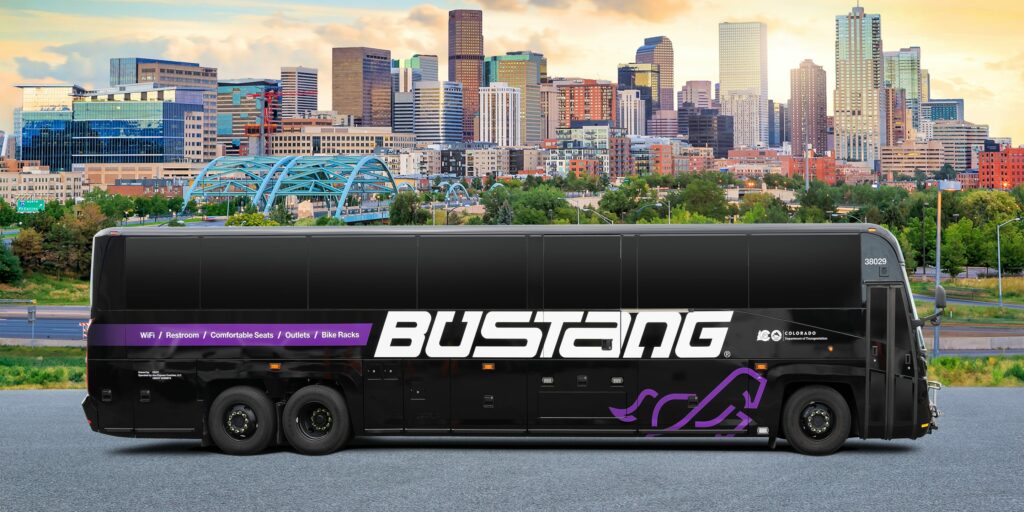
In the absence being able to provide any alternative bus transportation of their own, RTD turns to CDOT’s Bustang who help out by accepting tickets between Sky Ridge, Colorado and Denver Union stations on their south line. A 50 seater coach, 8 times a day is not a lot, but it is… something.
Jun 12th, 2024 – RTD Launches a Dedicated Light Rail Speed Restrictions Webpage
In what could be one of the few positives to come out of this whole affair, RTD launches a dedicated webpage for the light rail speed restrictions. A surprising amount of information is uploaded, including the agencies responses to the Colorado PUC (see below). The plan is clearly to try and answer everyone’s questions in one place. It’s certainly very welcome, but a growing number of GDT’s questions remain unanswered.
Jun 12th, 2024 – GDT Supplies Public comment to the RTD OSS Committee
“I’m just pretty baffled right now at [RTD] staff’s lack of creativity, lack of contingency plan and lack of respect for riders.”
Jaime Lewis, RTD Director District A, June 2024
On June 12th, 2024, GDT supplied public comment to the RTD Operations, Safety & Security Meeting including questions that we made it clear we wanted responses to. There follows in the meeting a discussion item (starts at 2:28:18) where numerous Directors including Jaime Lewis spoke about the disruption and its effect on riders.
Jun 14th, 2024 – Colorado PUC Letter to RTD
“The poor condition of the downtown rail lines and the deterioration of the SE line indicate that the PTASP has not been adequate to identify these conditions ahead of time so that repairs can be made in a measured way that minimizes impacts to the traveling public.”
Rebecca White, Colorado PUC Director, June 2024
On June 14th, 2024 the Colorado Public Utilities Commission (PUC) sent a scathing letter to RTD’s Management detailing a number of performance issues such as deficient asset management, safety plans and maintenance planning procedures. The agency’s Transit Asset Management Plan (TAMP) and Public Transportation Agency Safety Plan (PTASP) were heavily criticized as “not being adequate”.
“The PUC was not notified of these [issues in track conditions] findings along the SE line nor the issuance of a slow order but rather learned of this development through media inquiries.”
Rebecca White, Colorado PUC Director, June 2024
In addition, RTD’s failure to report safety issues to the PUC in a timely manner and general lack of transparency to the public were highlighted in the letter.
“As a rail transit professional, I cannot emphasize enough how serious this letter is. The Colorado PUC have been absolutely scathing in their assessment of RTD’s asset management, safety plans and maintenance planning procedures. Riders on the E, H & R lines have born the brunt of these failures.”
Richard Bamber, Greater Denver Transit Co-founder, June 2024
Jun 19th, 2024 – GDT Letter to RTD
On June 19th, 2024, GDT sent a letter to RTD requesting full answers to our questions (including those sent to the Operations, Safety & Security Committee on Jun 12th, 2024) and for the agency to take a series of actions to mitigate impact to riders.
Jun 21st, 2024 – RTD Responds to the Colorado PUC
“Regarding your assertion that the Joint Labor Management Safety Committee, RTD Board, and PUC approved Public Transportation Agency Safety Plan (PTASP), which documents the processes and procedures to implement a Safety Management System (SMS), is not adequate, I firmly disagree.”
Debra Johnson, RTD GM & CEO, June 2024
On June 21st, 2024, RTD responded to the Colorado PUC. While the letter detailed how RTD was providing the information requested provide the information requested, it made it clear that RTD disagreed with the PUC’s assertions that the Public Transportation Agency Safety Plan (PTASP) is “not adequate”.
Disagreeing with your regulator is always an interesting situation, we await with interest the next move…
Jun 24th, 2024 – Special Board Meeting
On June 24th, 2024, a special board meeting was held to discuss the crisis. RTD staff said they had been using the APTA standards since May 2024. Just to be sure, the exact document cover features in the presentation at 21:32.
On a side note, the meeting featured a bizarre and out-of-touch speech by RTD Director Guzman (2:04:12) who suggested riders should use buses running parallel to the SE corridor (which ones?), and utilize the extended journeys to “read through that book” or “listen to that podcast”!
Jul 3rd, 2024 – 10mph “Slow Zones” Extend to County Line
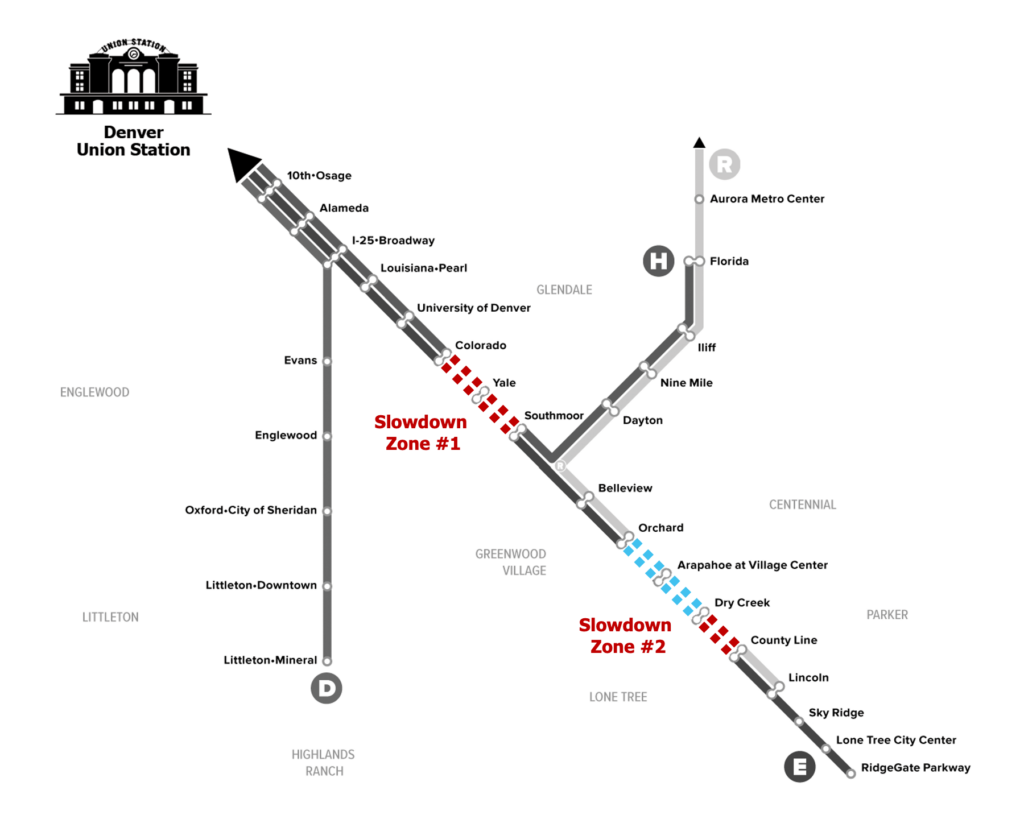
The latest map shows additional slow zones being added on the E and H Lines at County Line. The slow zone between Orchard and Dry Creek has been lifted in the northbound direction.
The accounts of delayed trains, missed appointments, people being late for work continue as RTD refuses to publish an updated (and therefore workable) schedule.
Jul 11th, 2024 – September 2024 Service Change Date Moved
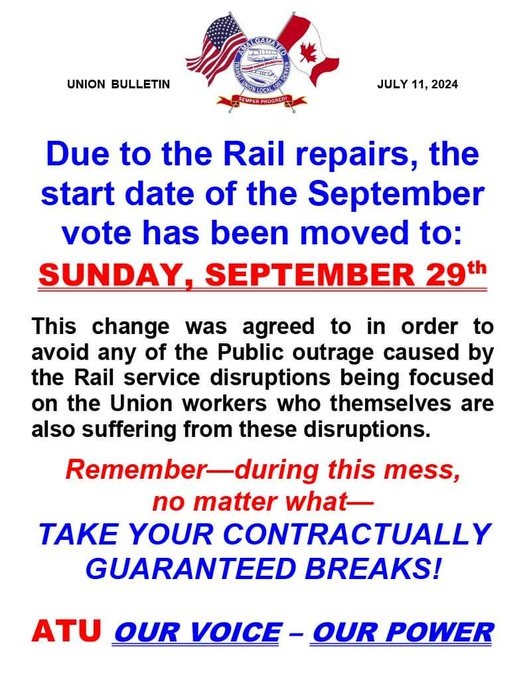
Via a bulletin from the Union, ATU1001, it emerges that RTD has delayed the start of the September 2024 service changes by two weeks from the 15th to the 29th of that month.
The Union also uses the same bulletin to remind its members that none of this situation (“mess”) is their fault and that operators should take their contractually guaranteed breaks.
Jul 12th, 2024 – RTD Responds to GDT
On July 12th, 2024, following some back and forth, RTD responded to GDT’s requests for answers. In fairness the agency made a great effort to answer us fully which is to be applauded.
The email stated that the 2021 RTD MOW Track Safety Standards took until May 1st, 2024 to implement due to the need to produce “standard operating procedures and training materials”. Three years to complete this, on the surface, does appear to be an extraordinarily long time.
Sadly the email blames two of RTD’s biggest problems for the lack of decent alternative choices for riders – the operator shortage and the ability to only change schedules three times a year.
Jul 19th, 2024 – 10mph “Slow Zones” Spread to the D Line
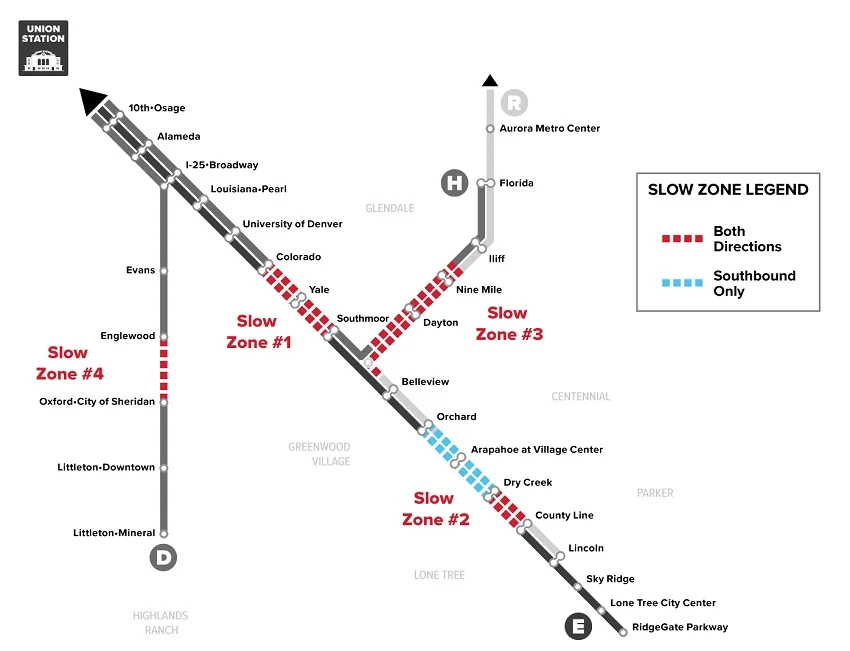
The latest map shows additional slow zones being added on the D Line and on the shared H and R tracks around Nine Mile station. No slow zones have been lifted since the last update.
The “muddling through” with an unworkable schedule continues…
Jul 22nd, 2024 – 10mph “Slow Zones” Lifted Between Orchard and Arapahoe at Village Center
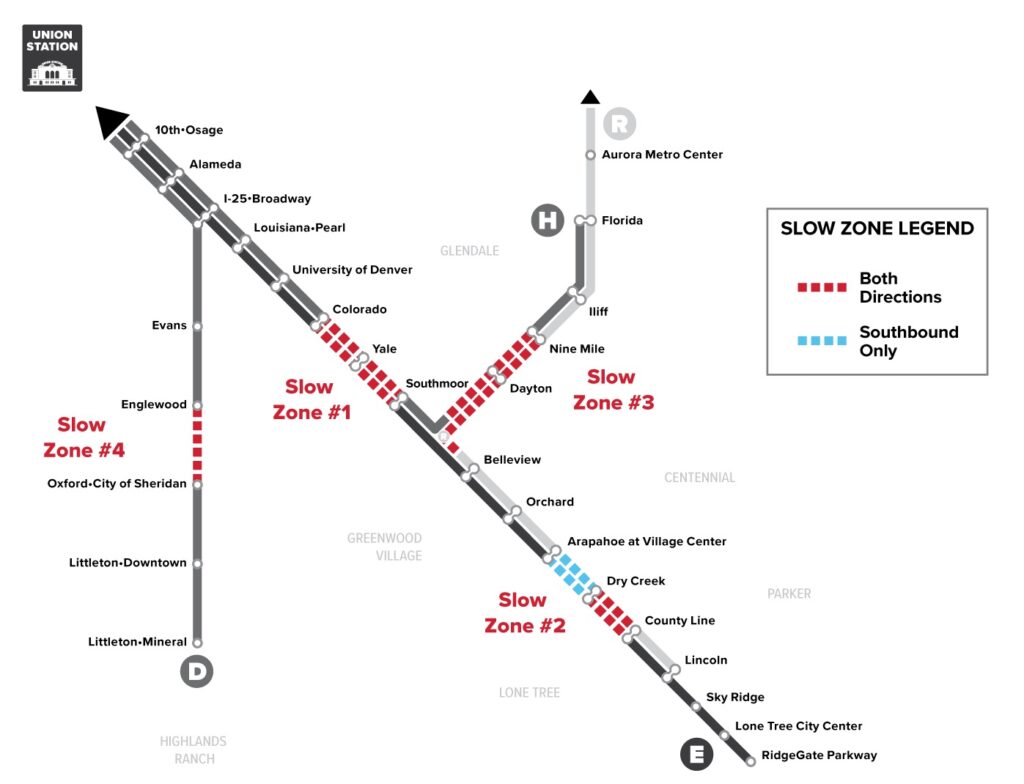
The latest map shows the southbound slow zone has been lifted between Orchard and Arapahoe at Village Center.
Jul 23rd, 2024 – 10mph “Slow Zones” Spread on the D, E and R Lines…
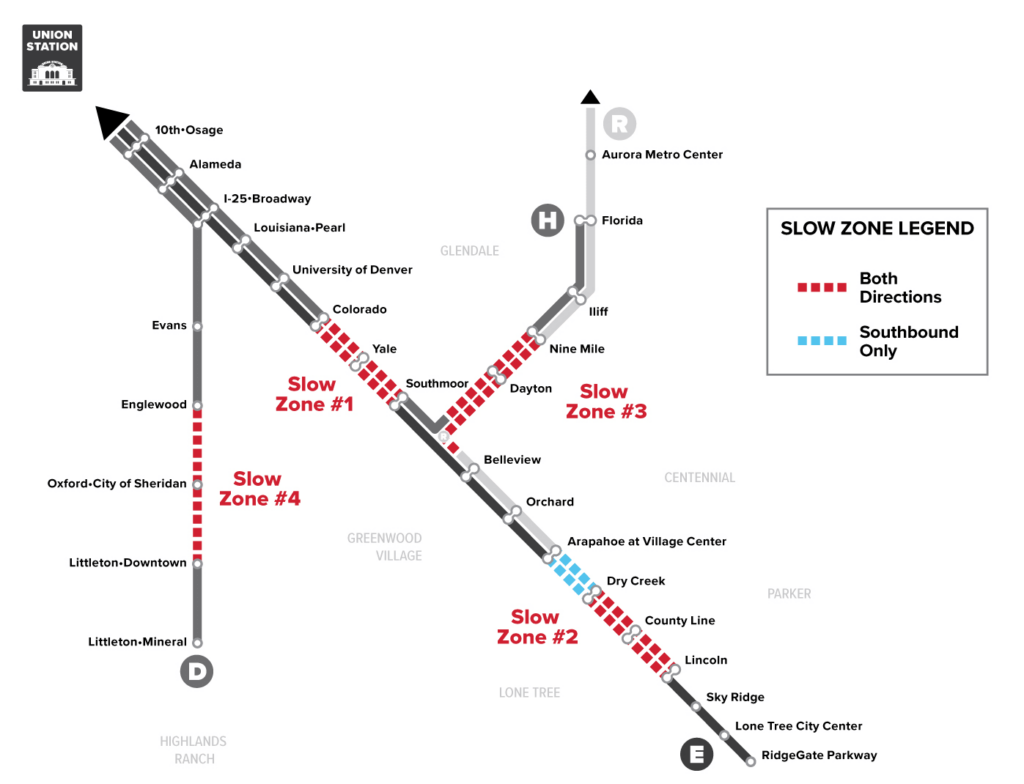
Yesterday’s improvements are cancelled out with the slow zones on the D, E and R lines increasing in length.
Jul 24th, 2024 – One southbound 10mph “Slow Zone” Eliminated on the E and R Lines…
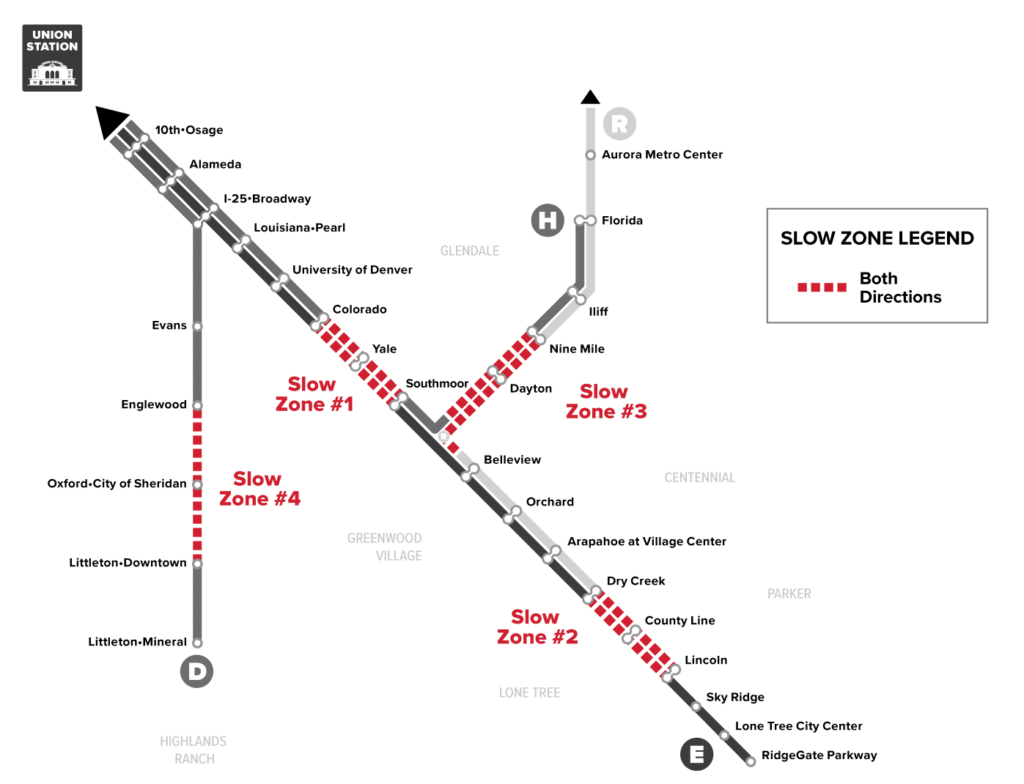
Arapahoe at Village Center to Orchard station is now back at full speed!
Aug 15th, 2024 – 10mph “Slow Zones” Creep North on the D, E and H Lines…
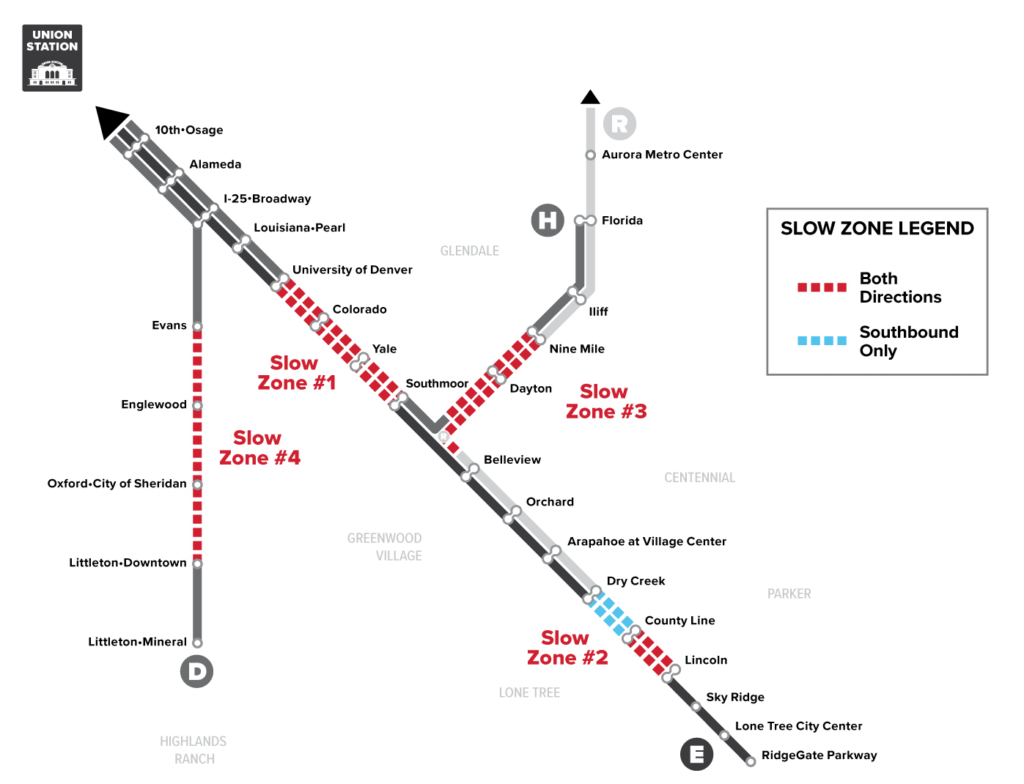
It’s a case of one step forward but two steps back this week as while the Northbound slow zone between Dry Creek and County line has been lifted, Evans and University of Denver join the list of stations affected.
Aug 27th 2024 – RTD GM & CEO Comments
“Everyone gets excited when something is shiny and new. Let’s see if my colleague is over there. Where is he? Nate Minor. Hi! So I call you out specifically as we talk about, everybody has their undies in a bunch because we’ve had some operational challenges.”
Debra Johnson, RTD GM & CEO, August 27th, 2024
On August 27th, 2024, at a public event, the RTD GM & CEO made comments to transportation journalist Nate Minor that basically said that the press, riders and advocates were basically overreacting to the situation on light rail.
Sep 10th, 2024 – Some Progress Made Between County Line and Lincoln
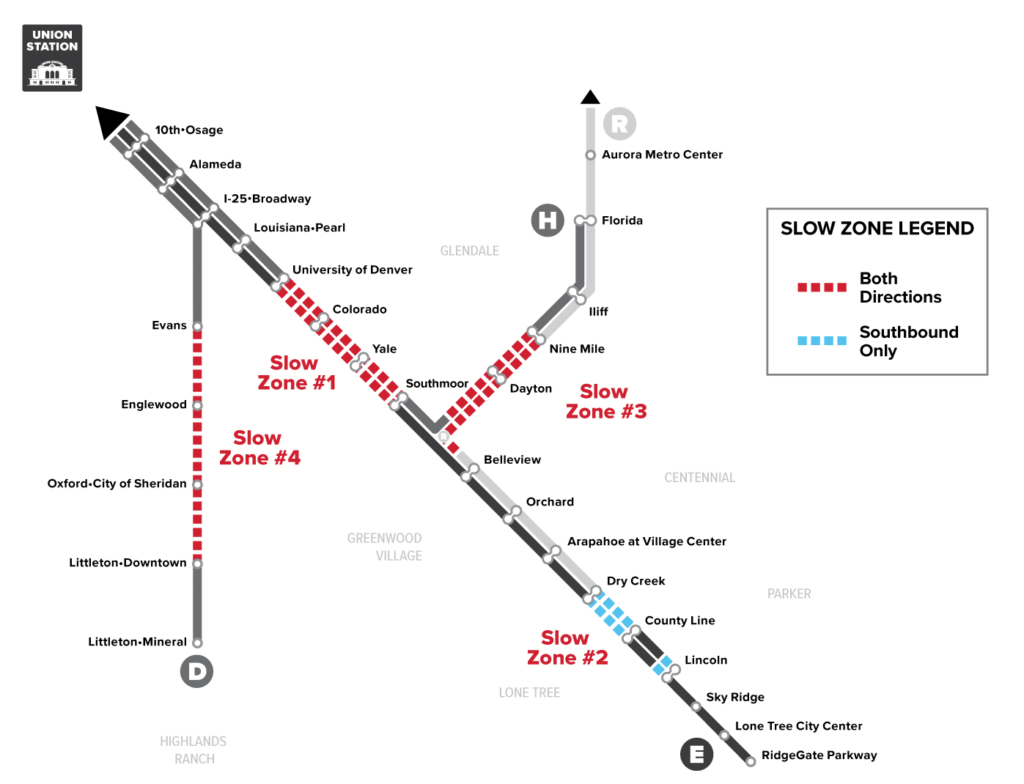
There’s some progress to report between County Line and Lincoln on the E and R Lines as all of the the northbound and most of the southbound 10mph “Slow Zones” have been lifted. That said, lots of sizable areas remain going in to September, 3 months since the start of the crisis.
Oct 4th, 2024 – Slow Zones on the South End of the E and R Lines Eliminated
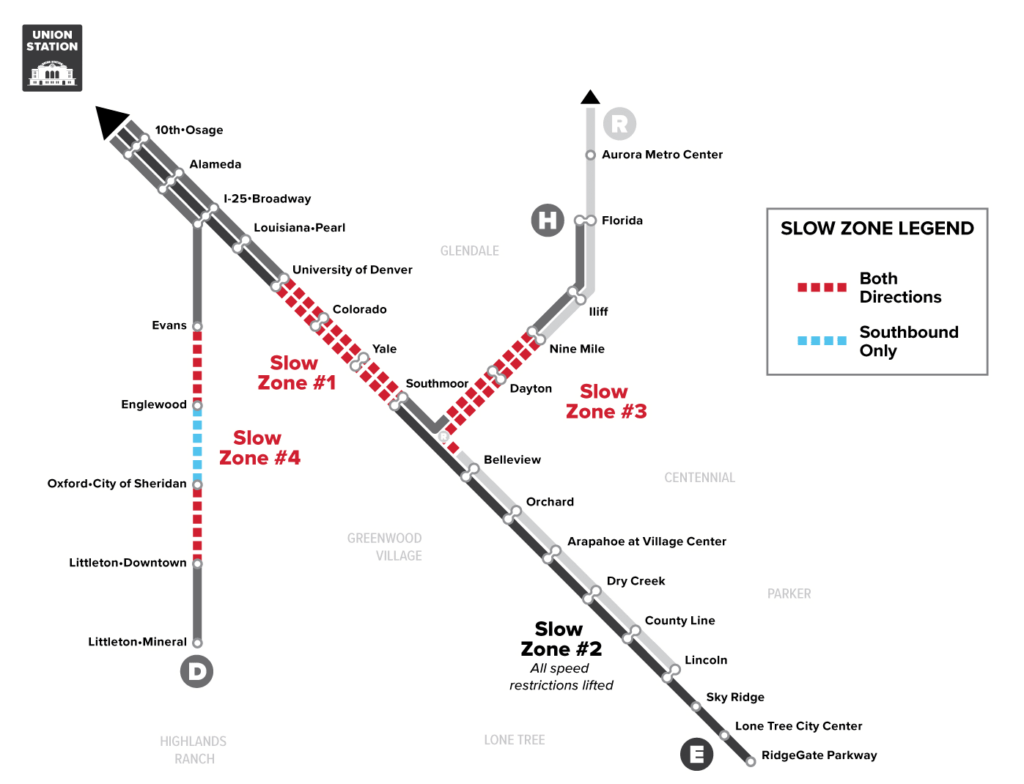
The big news this month is that the 10mph “Slow Zones” have been eliminated on the south end of the E and H lines. Progress has also been made on the D Line however, lots of sizable areas remain in October, 4 months since the start of the crisis.
Oct 18th, 2024 – Northbound Slow Zones on the E and H Lines Eliminated
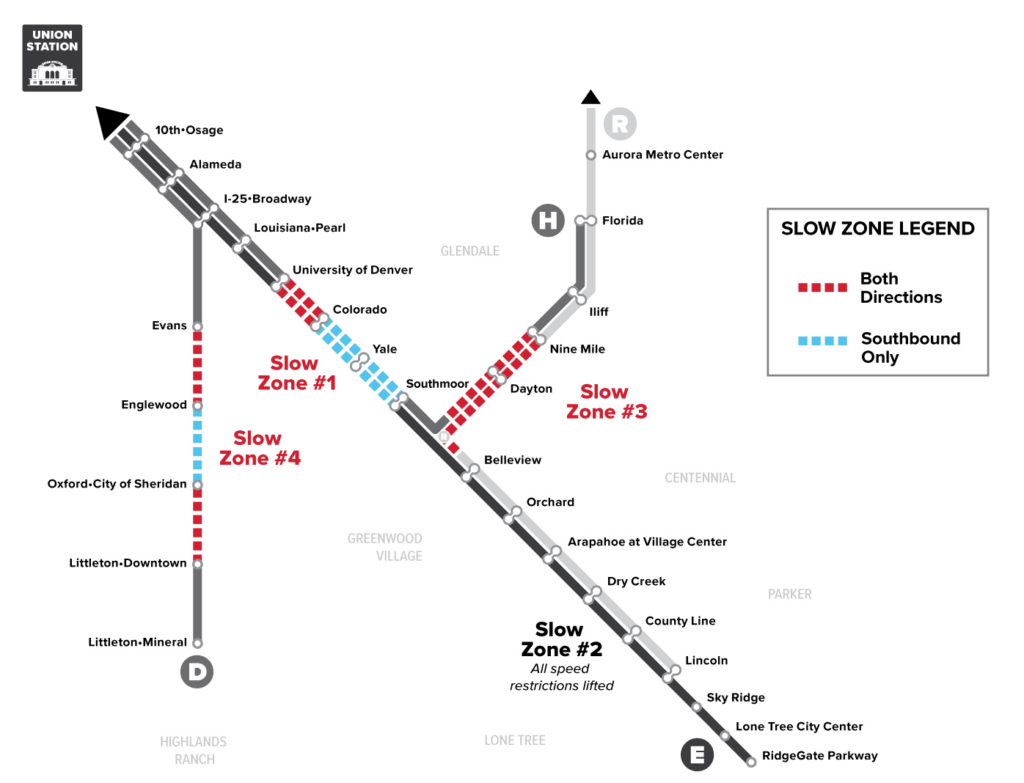
This latest update sees the elimination of 10mph “Slow Zones” in the northbound direction on the E and H lines between Colorado and Southmoor.
Oct 28th, 2024 – Slow Zones on the D Line Eliminated
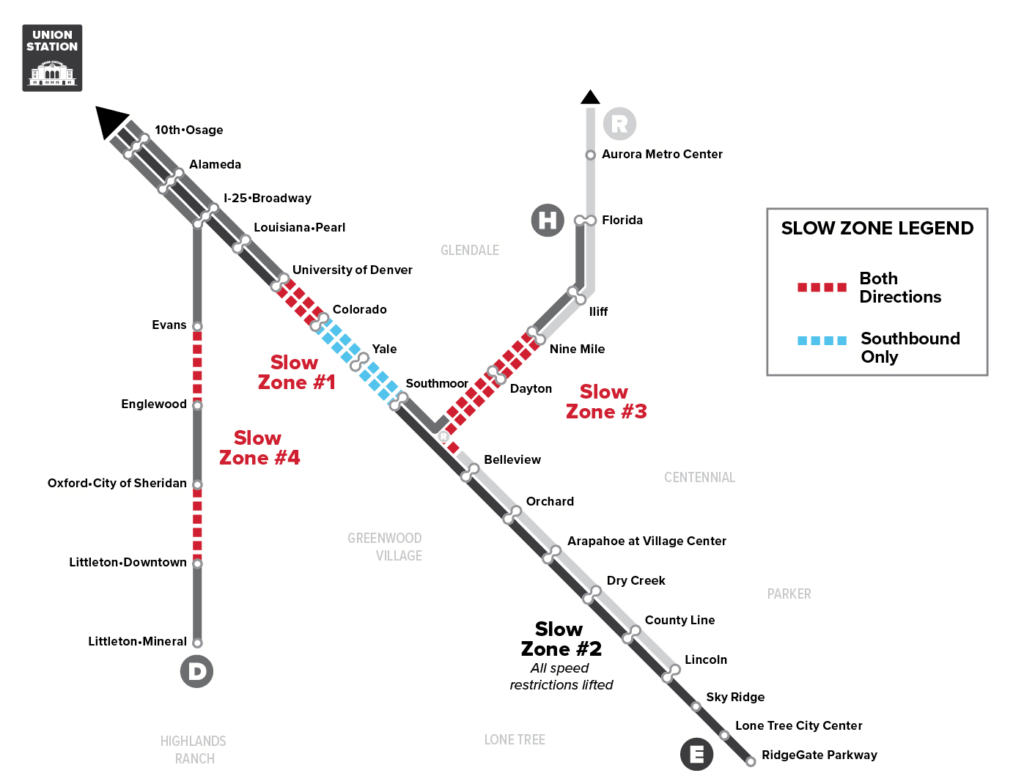
This latest update sees the elimination of 10mph “Slow Zones” in the northbound direction on the D line between Englewood and Oxford – City of Sheridan stations.
Nov 20th, 2024 – Progress on the E and H Lines
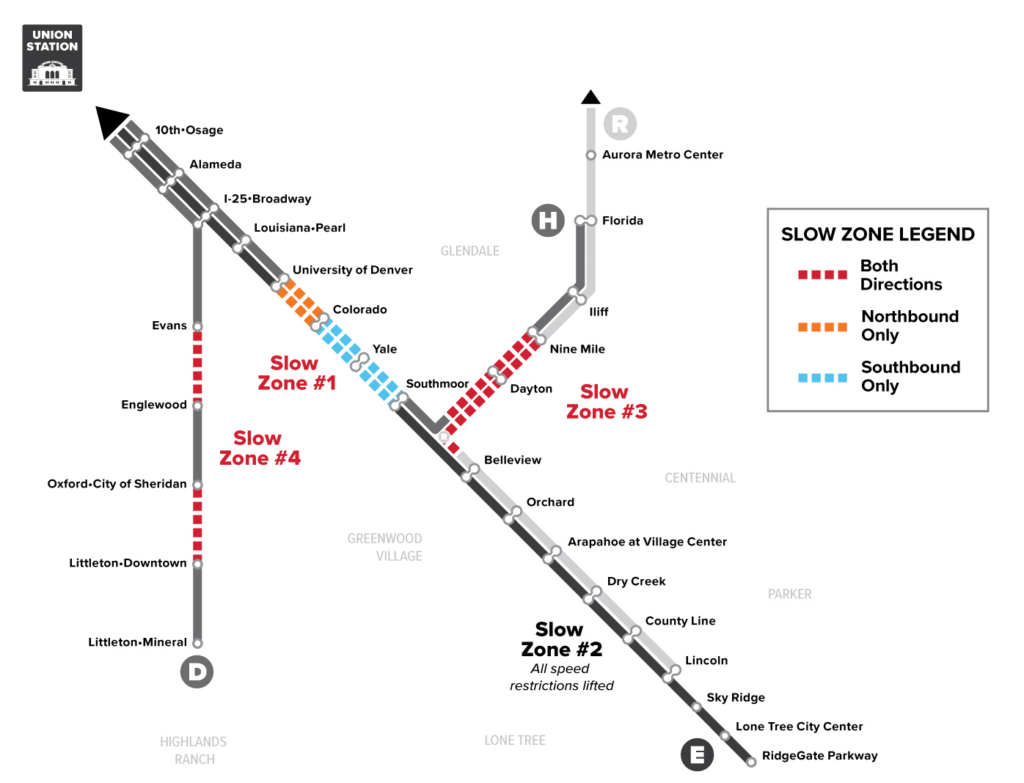
November sees the elimination of 10mph “Slow Zones” in the southbound direction on the E and H lines between University of Denver and Colorado stations.
Dec 30th, 2024 – Small Changes in Slow Zones, Crews Still Working
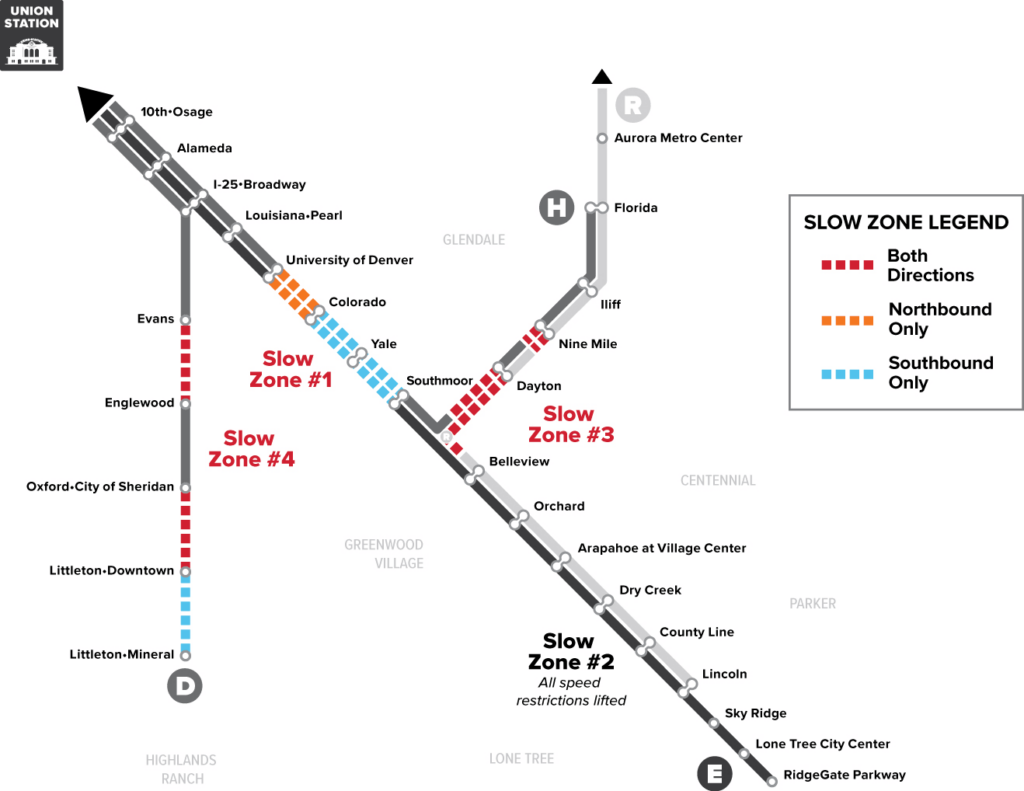
In a December 30th update, RTD stated that “Maintenance of Way (MOW) staff focused their efforts on mitigating railhead surface defects along the I-225 Corridor near the Nine Mile Station during overnight maintenance windows”.
Jan 31st, 2025 – Crisis Drags on into the New Year but Northbound E Line Trains are Now at Full Speed
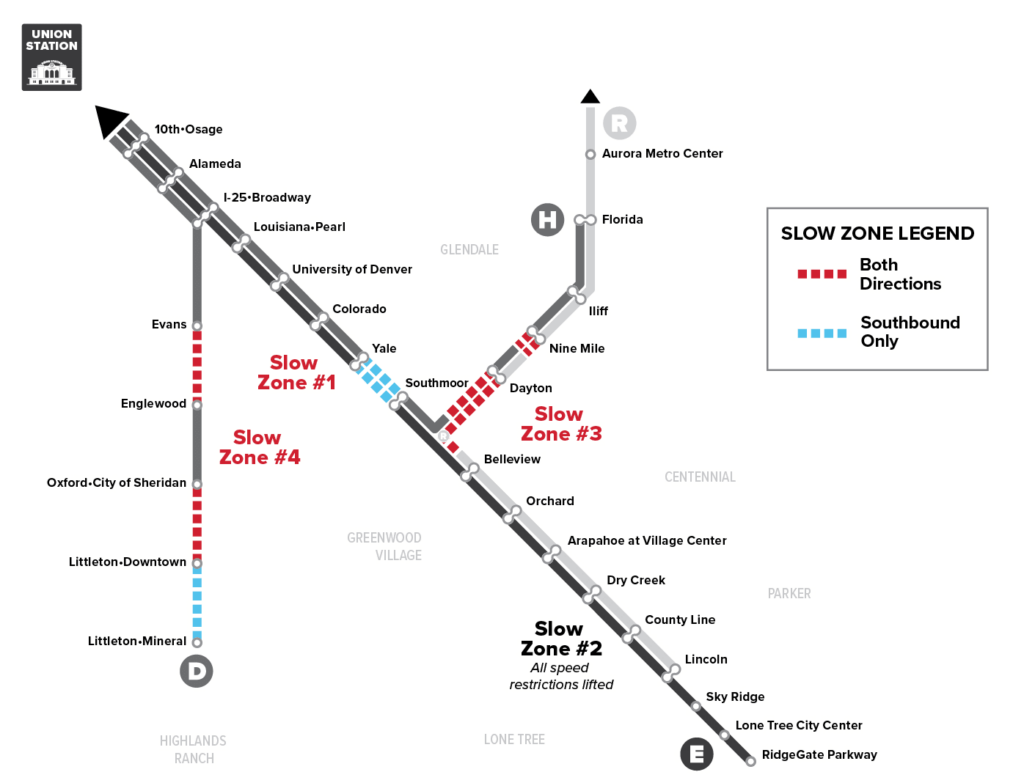
On Tuesday, January 28, 2025, RTD extended its overnight maintenance window to a three-day period to expedite repairs and remove remaining speed restrictions. During the three-day period, crews were able to complete planned maintenance work and lift two of the three remaining speed restrictions in Slow Zone #1. One temporary speed restriction remains in place on a section of the southbound track between Yale and Southmoor stations. All northbound E Line trains destined for Denver Union Station are no longer impacted by 10 mile-per-hour speed restrictions.
Feb 7th, 2025 – Northbound D Line Trains are Now at Full Speed
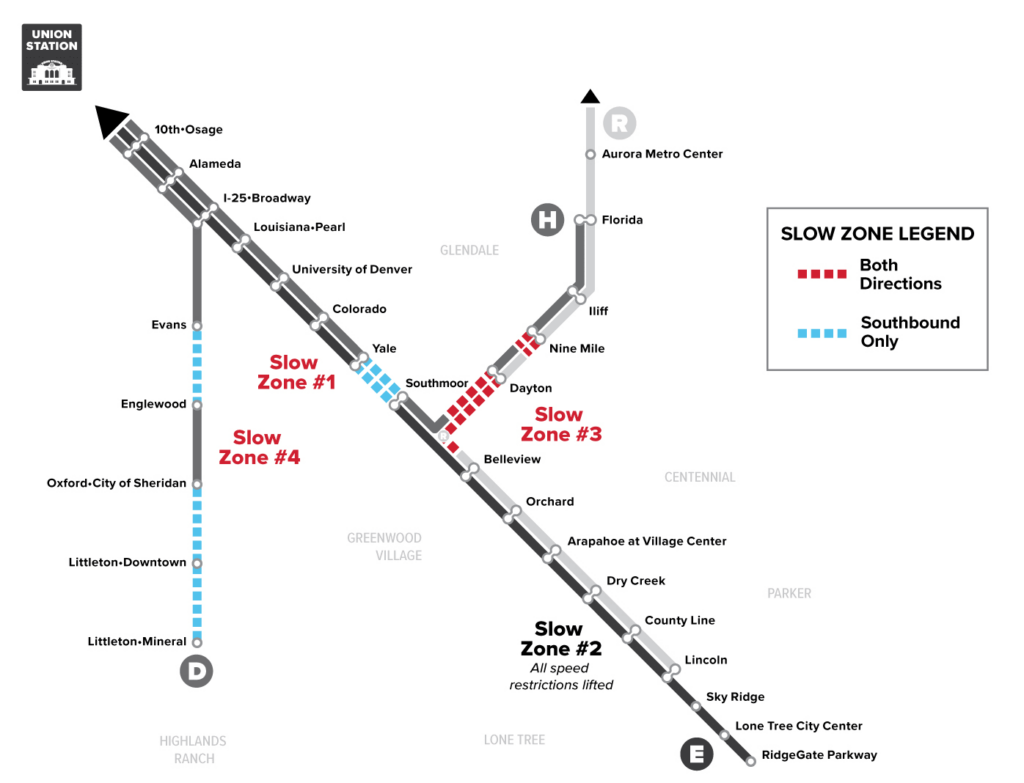
In a February 7th update, RTD said it had “removed all remaining northbound speed restrictions in Slow Zone #4 along the D Line, returning normal train speeds heading into Denver. Additionally, crews reduced the last remaining restriction in Slow Zone #1 by approximately 2,200 feet, significantly increasing (surely decreasing?) southbound travel times for light right customers along the E and H lines”.
Feb 14th, 2025 – Southbound D Line Slow Zone Between Evans and Englewood Lifted
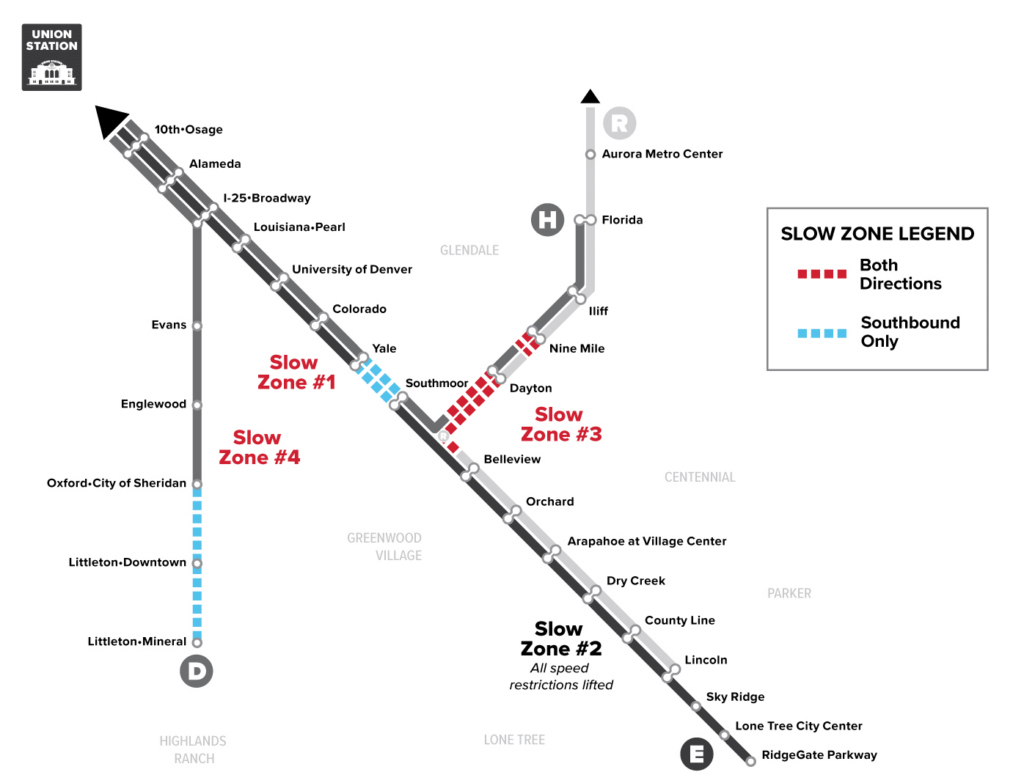
In a February 14th update, a southbound D Line slow zone between Evans and Englewood stations has been confirmed as lifted.
Mar 7th, 2025 – Three Light Rail Speed Restrictions Along the D, H, and R Lines Lifted
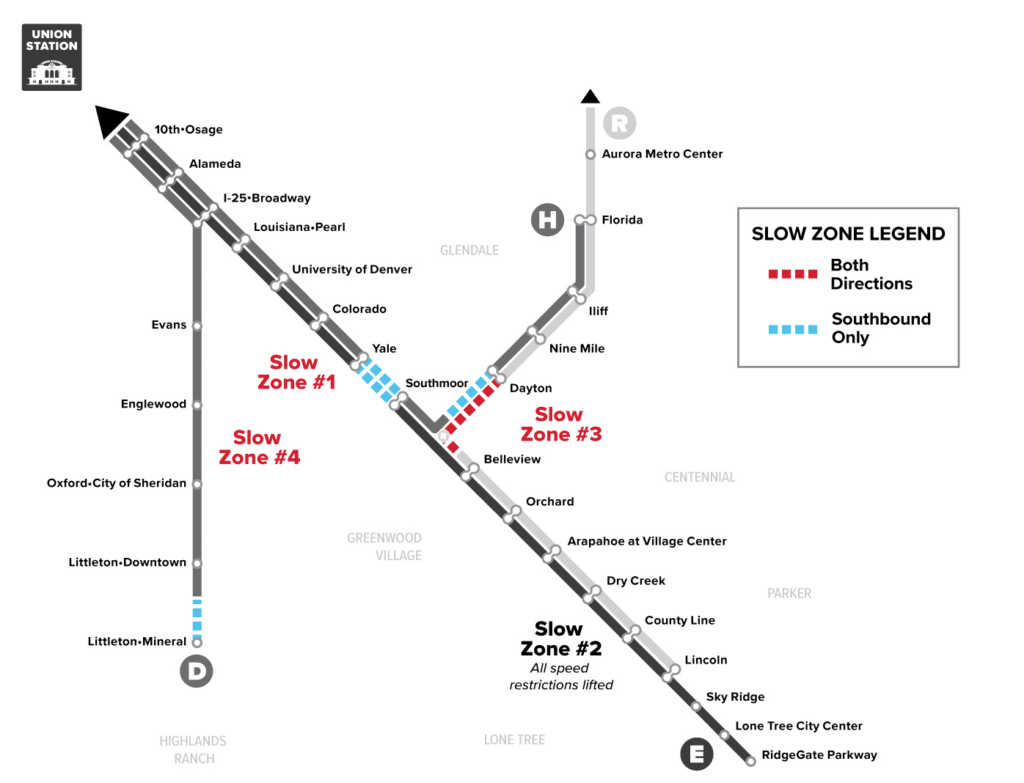
On March 7th update, RTD announced it had lifted three light rail speed restrictions along the D, H, and R lines. 9 months after the crisis started, we are now down to 3 slow zones.
Apr 3rd, 2025 – Slow Progress…
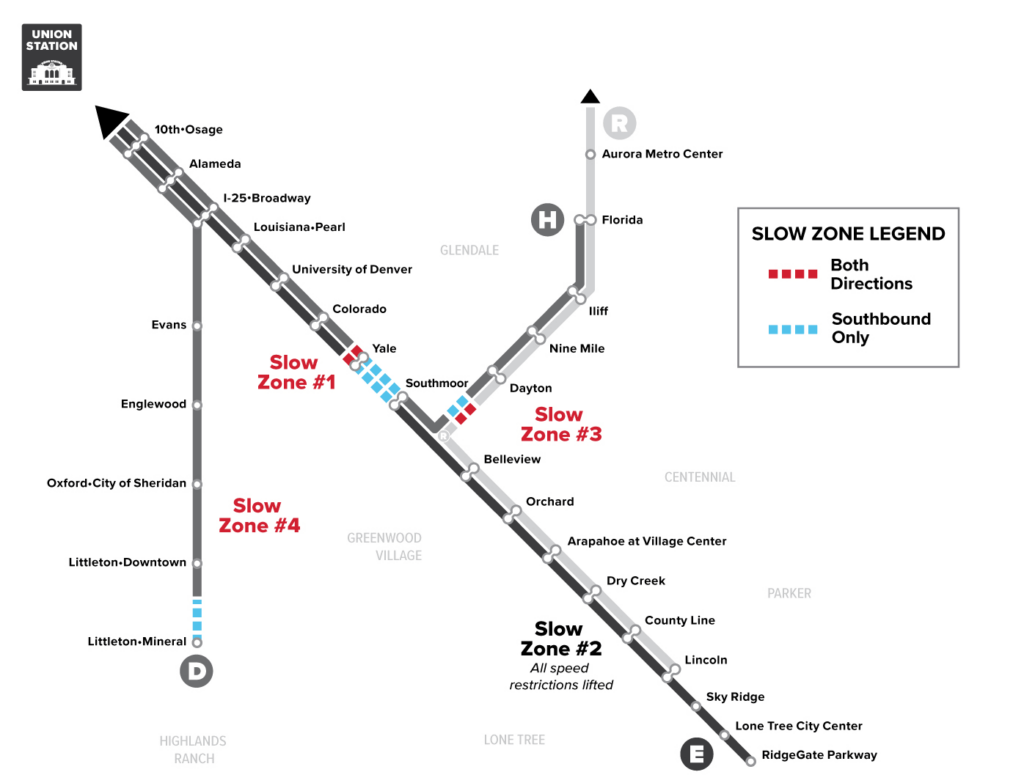
In an April 3rd update, RTD showed a few slow zones becoming both directions again but pointed out that these mainly affect switches and not lengths of regular track.
May 9th, 2025 – Is the end finally in sight?
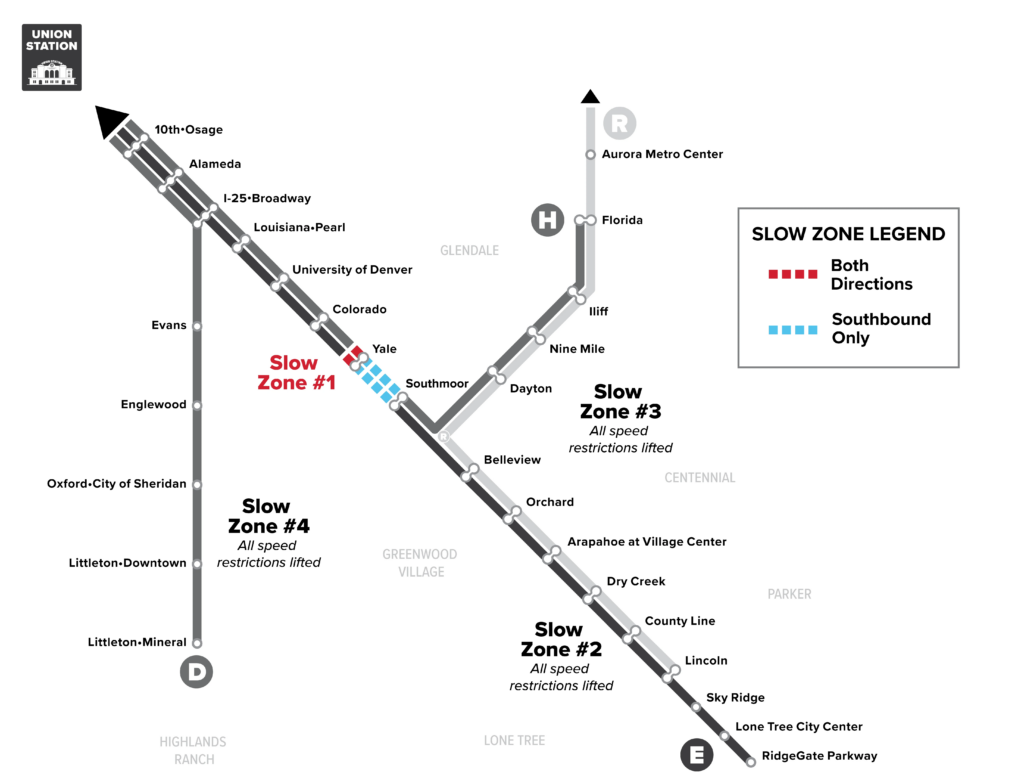
With all speed restrictions on the D and R lines fixed, we are left with one section in the Yale / Southmoor area, the majority of which is southbound only.
May 27th, 2025 – ALL SLOW SZONES ELIMINATED!
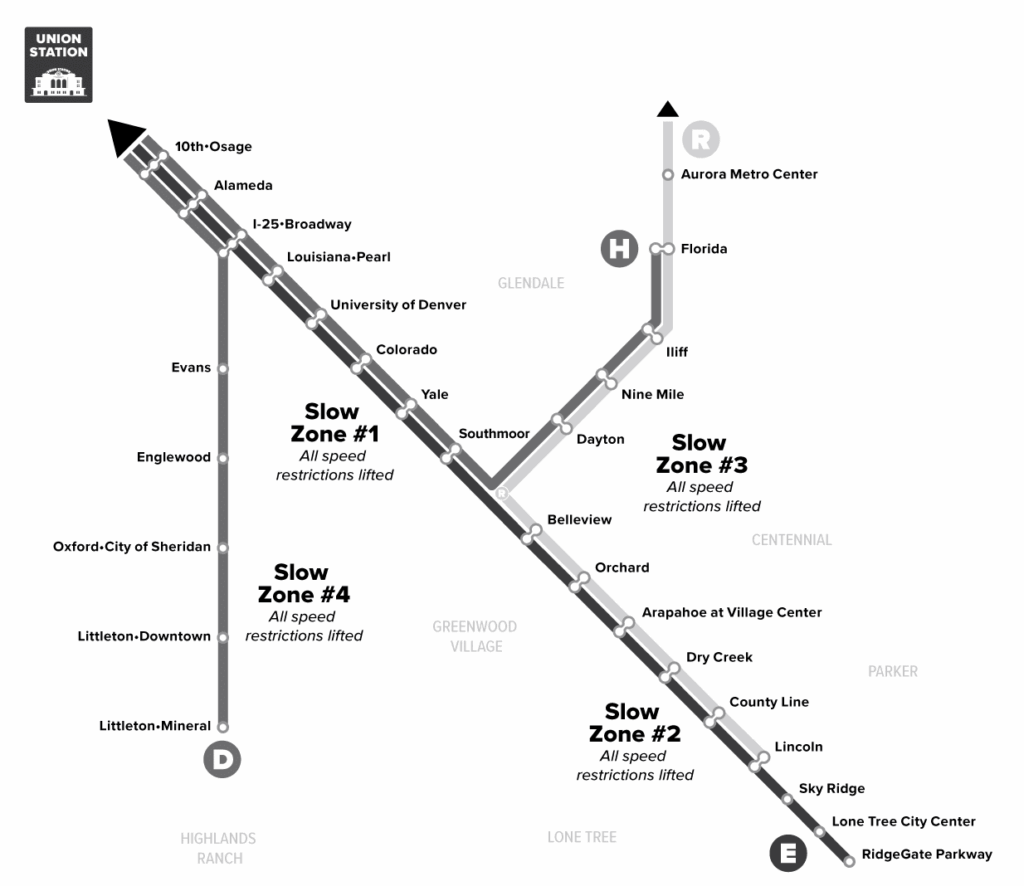
ON May 27th, 2025, 51 weeks after they were first imposed, RTD announced that the last ‘slow zones’ have been removed from the network.
Our View…
Greater Denver Transit continues to be extremely disappointed in the way this incident was handled from a customer’s point of view.
– RTD has not been forthcoming with the fact it has had a track inspection standard that mandates 10mph “slow zones” in response to “rail burn” since 2021. This makes assertions that staff could not have reasonably foreseen the sudden imposition of “slow zones” hard to believe.
– RTD’s unwillingness and / or inability to publish emergency schedules to replace the current unworkable schedules means that riders have very little certainty of when trains will arrive at their destinations. This has destroyed connections and also greatly affected operators who have had break times cut into while bearing the brunt of customer’s frustrations.
– RTD’s inability to provide supplementary bus shuttles due to a lack of operators is another example of how leadership’s failure to solve one of the agency’s biggest problems continues to negatively affect riders.
– This crisis has prompted RTD to be more transparent by proactively publishing documents on its website, which is welcomed.
– The GM & CEO’s comments on August 27th, 2024 were completely unacceptable and showed how out of touch she is with what RTD’s customers have had to put up with this summer. The comments give us little confidence that the rider experience will dramatically improve under her leadership.